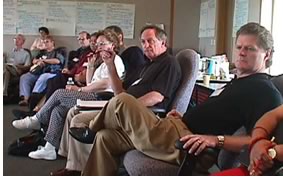
AIA elected leaders and senior staff held a two-day marathon strategic planning session July 30–31 in the secluded hills of West Virginia to evaluate 2001 programs and set a direction for 2002 and 2003. The ongoing goal is to increase the value of the AIA to its members within a tight budget.
AIA First Vice President Gordon H. Chong, FAIA, and Executive Vice President/CEO Norman L. Koonce, FAIA, grounded the objective-setting meeting in the long-range AIM (Aligning the Institute for the Millennium) plan and attuned it to membership expectations by inviting the 2002 Executive Committee to participate. Moderating the session was Jim Dalton, who had also served as the Institute's chief consultant in the implementation of the AIM plan.
 In
preparation for the two-day conference, Chong and Koonce agreed on three
AIM objectives to frame the discussions: architectural education, professional
knowledge collection and delivery, and membership inclusiveness.
In
preparation for the two-day conference, Chong and Koonce agreed on three
AIM objectives to frame the discussions: architectural education, professional
knowledge collection and delivery, and membership inclusiveness.
"To achieve the ambitious and necessary business goals that delegates set at the 2001 convention, we are determined to use every tool at our disposal to work smarter, and harder," Koonce said.
"We are applying our strongest asset as architects—the design process—to this planning," Chong amplified. "Through objective setting, schematic conceptualization, idea synthesis, and strategy development, we are continuing our commitment to enhance the Institute's leadership position in the design professions and construction industry.
"This is not a one-year planning process. I am continuing the efforts of President John Anderson, and Thom Penney has made it clear that he will continue our work when my term is complete to ensure a dedicated and sustained effort."
Copyright 2001 The American Institute of Architects. All rights reserved.
![]()
|
First Vice President-elect Thompson E. Penney, FAIA, foreground, and, to his right, EVP/CEO Koonce consider a comment from Treasurer-elect Douglas L. Steidl, FAIA (not in picture). |
|